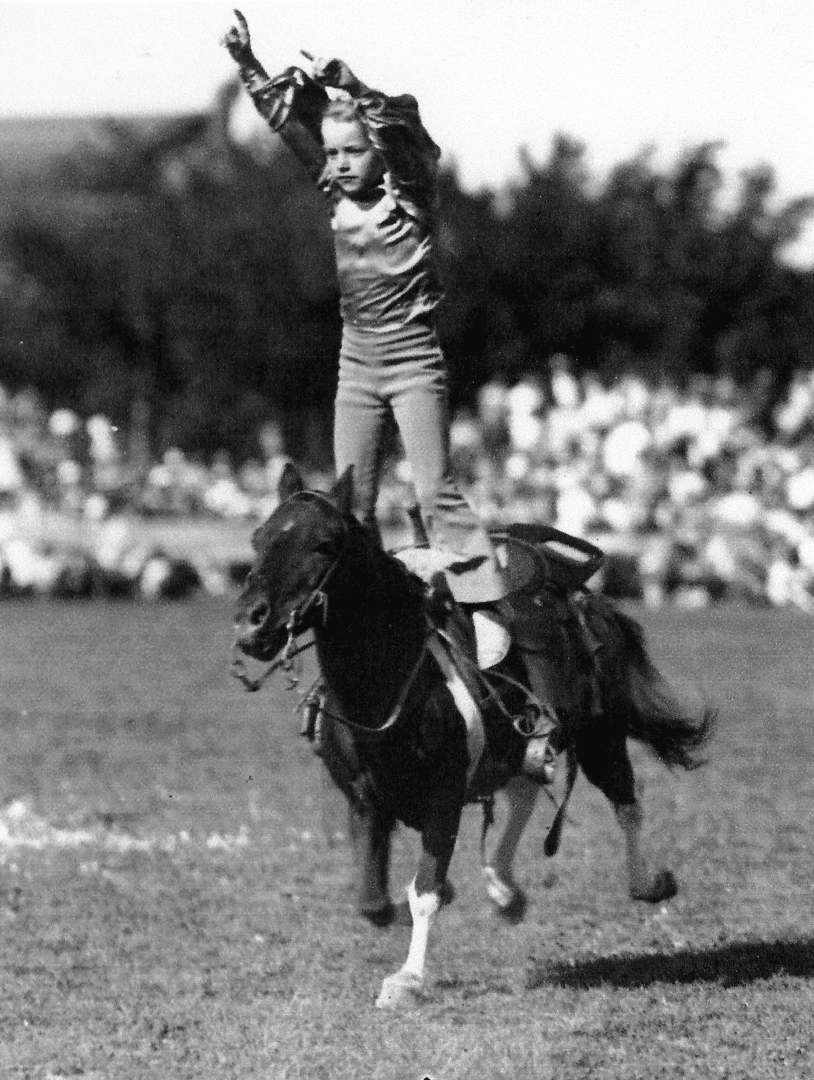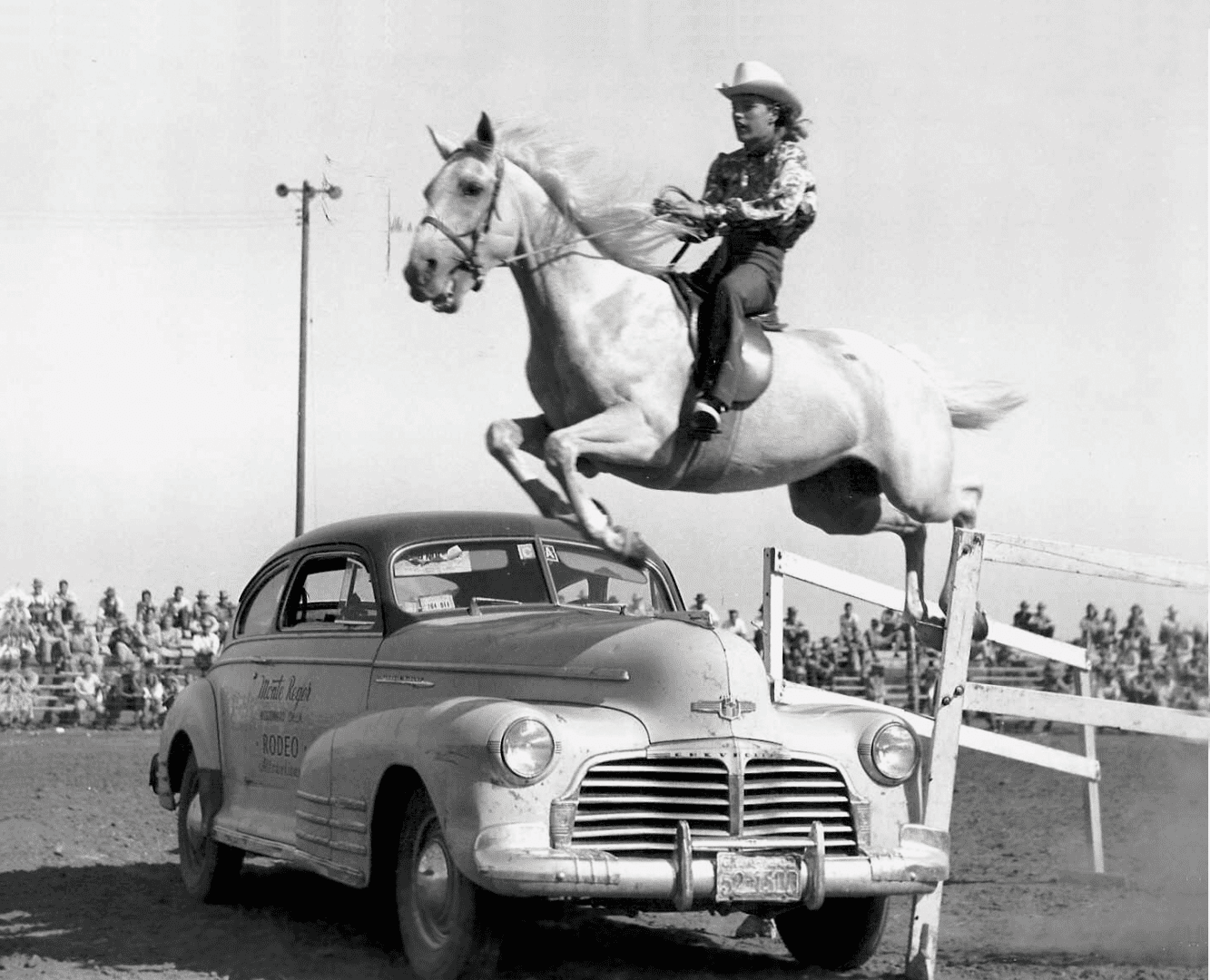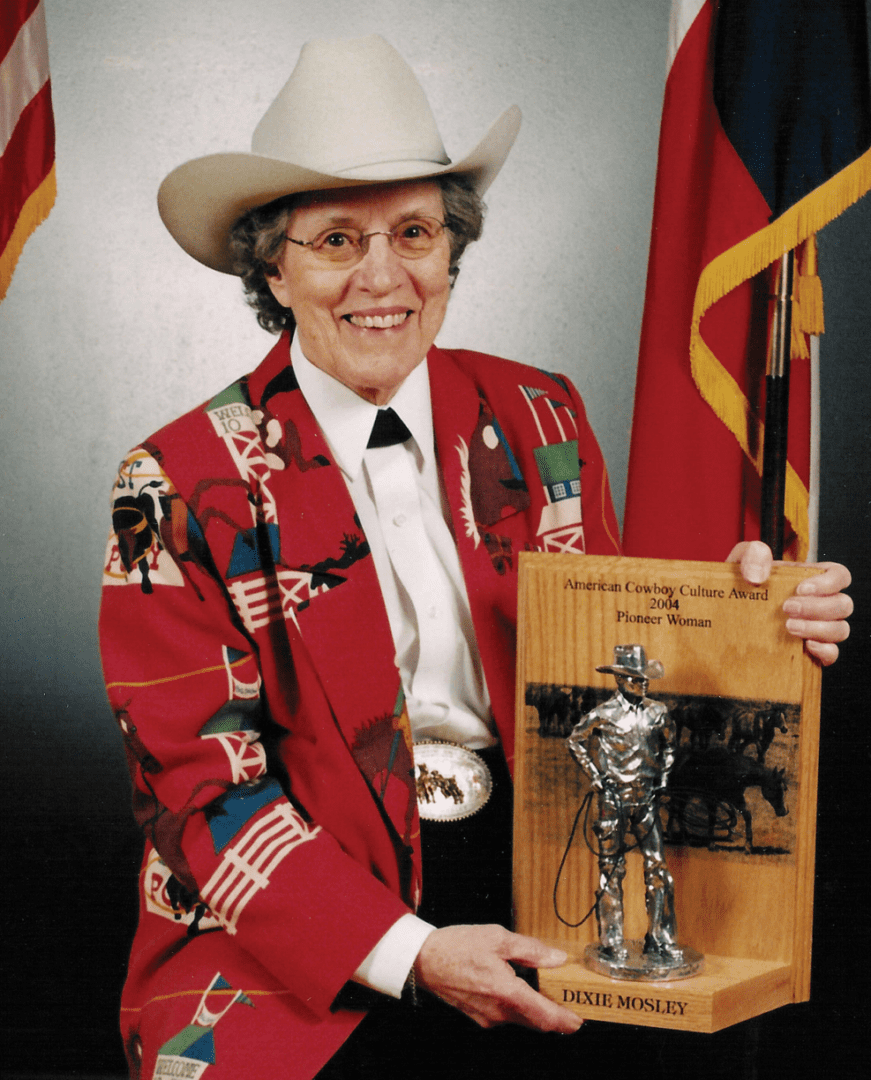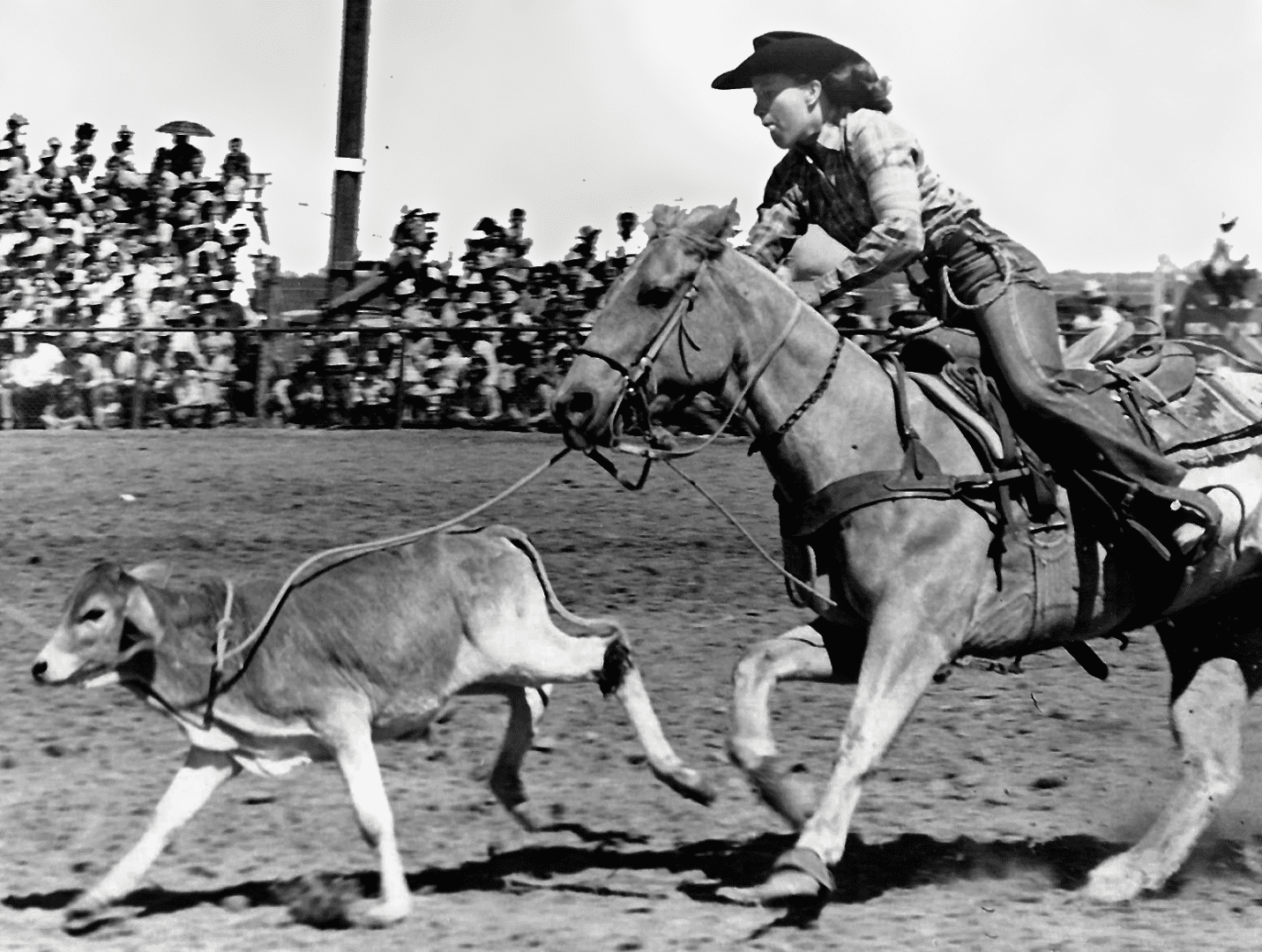Dixie Mosley of Amarillo, Texas, had a most unusual childhood. The third and youngest child of Monte and Opal Reger, Dixie was born in Buffalo, Okla., on October 3, 1930. Before her sixth birthday, she had travelled more of the U.S. with her family than most people of that era saw in a lifetime. The Reger family were rodeo entertainers, fulfilling rodeo contracts in the eastern half of the country, and travelling with an 18 foot Schult house trailer, several trick horses, and a longhorn steer in tow.
It was Bobby the Longhorn Steer that propelled the Regers into their lifestyle of greasepaint faces and trick riding Death Drags. The Longhorn/Brahman cross had curvy horns measuring 8′ 6″, and at the time he was discovered by Monte Reger, the steer was known for his rank personality. But Reger saw potential in the tremendous bovine, and with dreams of leaving the farming life behind, he tamed Bobby. Soon, Reger was riding the steer like he was a trusty cowhorse, as were Dixie and her brother, Buddy, and sister, Virginia. Bobby and Reger even appeared in a movie, Wheels of Destiny, in Hollywood, and advertised for a barbecue chain in Burbank, Calif. But Bobby was best known for his iconic jumps, clearing a convertible with ease while directed on a lunge line by Reger.
Though Reger had helped start the rodeo in Doby Springs, Okla., he had bigger dreams. Eventually, he was announcing for the Beutler Brothers and performing with Bobby in Colonel Jim Eskew’s Wild West Show. Eskew’s son, Jim Eskew, Jr., taught Dixie to trick ride and rope by the time she was five. She began performing alongside her brother and sister, riding a Shetland pony named Tom Thumb. Her brother, Buddy, was a rodeo clown, while Dixie and her sister represented the family in trick riding and roping. Their mother, Opal, occasionally took off her apron to perform the Quadrille – square dancing with horses – but she preferred to live outside of the spotlight. “She had more than a full time job looking after Dad and us three kids, feeding us and sewing all our clothes,” Dixie recalls. “She kept us together.”
Dixie’s rodeo debut came in 1935 in Pittsburg. At five years old, she was a fearless performer. “I was never afraid of anything at a young age, and when you’re a teenager, you’re really not afraid!” says Dixie. She showed horses in western pleasure, and although she found nothing remarkable in her trick riding talents, rodeo spectators thought otherwise. As she grew, Dixie rode her family’s palomino American Quarter Horses that they bred, their fair coats reflected in the shining cars that Dixie jumped them over. Though the Regers stayed in their trailer or motels, they returned often to their home in Woodward, Okla., to “get cleaned up and go again,” according to Dixie. It was there that the family trained their show horses. They laid three 55 gallon drums down, placed two more on top, and finished with a heavy wooden door at the top to re-create the size of car Dixie jumped over, before practicing on the real thing.
For all the excitement of living on the road, Dixie at times longed for what she calls a normal life. “I wouldn’t take anything for the life I’ve had, but sometimes I wonder what it would’ve been like to have a different type of life,” Dixie says reflectively. “We had to be careful in the summertime to go swimming in the late afternoon. We didn’t want to take the chance of getting sunburned and not being able to ride the trick horse. Even rollerskating you had to be careful to not twist an ankle. We were being paid to be at the rodeo, and we couldn’t get hurt having fun!” Missing out on regular schooling was what Dixie regretted the most. Up until high school, she and her siblings were homeschooled by their mother, a box of curriculum from Calvert Correspondence School arriving once a year with schoolbooks. When she entered high school, she came to school several weeks late and left in May to accommodate rodeo season. Yet homeschooling had agreed with Dixie, and she was several grades ahead of children her age, entering high school when she was 12 and graduating in 1946, when she was 16.
In 1947, Dixie was clowning and performing in an all-girl rodeo in Amarillo, Texas, and the following year, the all-girl rodeo in San Angelo, Texas, was the birthplace of the Girls Rodeo Association (GRA). Dixie was a charter member, and later served as a contract representative and vice president for the association. In addition to trick riding and roping, she rodeo clowned for the GRA, the only woman in the area to do so. Dixie even rode several bulls and bareback horses, but the roping events like ribbon roping, breakaway, and calf roping, were what brought out her competitive side. “I’ve been bucked off and had horses fall with me, and I’ve never broken a bone,” says Dixie. “I’m real proud to be a charter member of what is now the WPRA. I met some wonderful cowgirls!” One of these cowgirls was the rodeo-renowned Tad Lucas, a bareback bronc rider and trick rider that Dixie created and performed several rodeo skits with. “She was a very nice lady, and she would do anything to help make the rodeo a better performance.”
By 1953, Dixie was 23 years old and ready to make a bold move. She retired from rodeo. Her final performance in the public eye was the inaugural all-girl rodeo in Colorado Springs, Colo. Following that, she married William Mosley in August of 1953. Bill was a cattleman, who served in both WWII and the Korean War, and was a friend of Dixie’s brother-in-law. “Growing up, I pretty much knew I didn’t want to marry a rodeo man,” says Dixie. “I think they are the most wonderful people in the world, but they’re always on the go! I wanted to stay home. Bill went back to college after he got out of the military, and I became a college wife. I got my PHT – Putting Husband Through,” she says with an infectious laugh.
After finishing college, Bill and Dixie settled in Amarillo, Texas, where they still make their home today. With partners, they built a meat packing house, and Dixie lived the life she’d dreamt of as a child, becoming a full-time wife and mother and living in a house that wasn’t on wheels. Their children, Judy, Clay, and Paul, all grew up riding horses, but didn’t pursue rodeo. Once their children were grown, Bill sold the packing house and became a cattle inspector. He and Dixie travelled the U.S. extensively, some of Dixie’s favorite travels taking her to the annual induction ceremony for the National Cowgirl Hall of Fame. She also attended Rodeo Clown Reunions held by Gail Woerner, where Dixie was the only female rodeo clown. Dixie herself was inducted into the Cowgirl Hall of Fame in 1982 and the National Cowboy Hall of Fame in Oklahoma City in 2003. She was named the Pioneer Woman of the Year in 2004 at the National Cowboy Symposium in Lubbock, Texas. Bobby the Longhorn Steer, who started it all, also holds a place of honor, his head mounted in the National Cowboy and Western Heritage Museum.
Memories abound, and Dixie has no regrets. She concludes happily, “I’m glad it’s all worked out the way it’s worked out.”
Story also available in our May 1, 2015 issue.












